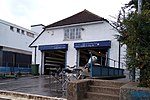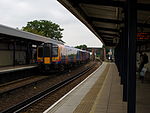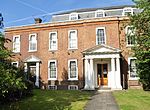Dukes Meadows Footbridge

Dukes Meadows Footbridge is a pedestrian bridge beside the River Thames in Chiswick in West London. Opened in 2023, it allows the Thames Path on the north bank at Dukes Meadows to follow the river without diversion. The bridge was designed by Moxon Architects as a "half through" truss structure. The footway is of stainless steel and aluminium. Planning permission for the design was granted early in 2019. CampbellReith were the consulting engineers for the bridge's structural, geotechnical, environmental, and civil engineering, with marine engineering by Marmus, electrical engineering by Slender Winter Partnership, and environmental consultancy by Thomson. Construction was by Knights Brown.
Excerpt from the Wikipedia article Dukes Meadows Footbridge (License: CC BY-SA 3.0, Authors, Images).Dukes Meadows Footbridge
The Terrace, London Mortlake (London Borough of Richmond upon Thames)
Geographical coordinates (GPS) Address Nearby Places Show on map
Geographical coordinates (GPS)
| Latitude | Longitude |
|---|---|
| N 51.473 ° | E -0.2544 ° |
Address
Barnes Bridge
The Terrace
SW13 0NR London, Mortlake (London Borough of Richmond upon Thames)
England, United Kingdom
Open on Google Maps











